The Dyna series is the least expensive way to get into a Big Twin Harley, starting at just $11,999 for the Super Glide model. Moving up in price is the Street Bob and the Super Glide Custom, followed by this new Wide Glide at a base price of $14,499. Dynas are easily recognizable by their exposed dual rear shocks and underseat battery box.
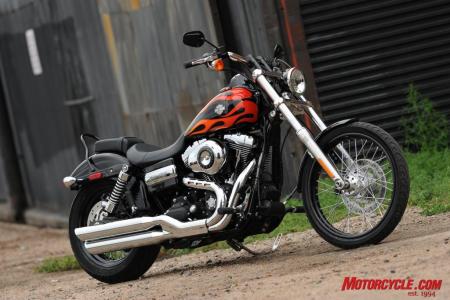 The 2010 Dyna Wide Glide strikes a pose. |
The WG gets its name from its wide-placed 49mm fork laid out in a generous chopper-style rake of 34 degrees. A consistent styling theme is the contrast of black and chrome. The wide chrome triple-clamps are accented with gloss-black handlebar clamps and risers, and this is mimicked in the 40-spoke wheels with black rims and the black headlight bucket highlighted by a chrome bezel. Similarly, the engine is powdercoated black and accented by machined cylinder fins and chrome-plated rocker and derby covers.
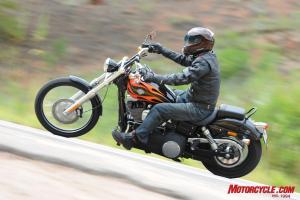
Harley ups the ante in the Dyna family with the new Wide Glide.
Also creating its own personality within the Dyna family is a black battery box with a chrome “Wide Glide” logo, a mini sissy bar and a new two-into-one-into-two “Tommy Gun” exhaust with slotted heat shields over the rear header. The front of its 4.7-gallon fuel tank is kicked up 0.75 inch for a jauntier angle that contributes to its chopper profile and the feeling of sitting “in” the bike.
Like many of Harley’s new models, there is a focus on reducing seat heights to give riders a greater feeling of confidence. As such, both ends of the suspension have been cut down to yield a seat just 25.5 inches from the ground. In comparison, the Dyna Super Glide’s seat is placed at 26.3 inches.
The back end of the Wide Glide is interesting for two reasons. First, there is no traditional stoplight, instead using the red-lens turnsignal lamps as stoplights as first seen on the Nightster. This innovative arrangement and chopped rear fender provides an ultra-clean rear end. The surprising part of this story is that European regulations do not allow such a system, so those on the Continent have to suffer with a traditional taillamp as seen in our action photography. For a change, North Americans get cooler stuff than the Euros!
Wide Glide Ride
Straddling the new WG is effortless thanks to its low seat, but the reach to the forward-set pegs is a stretch for those with short inseams. The internally wired 1.25-inch handlebar is set on 4-inch risers for a drag-style posture – fists punching the air – which rotates a rider’s spine into a comfortable curve.
Low-speed maneuverability is typical of a raked-out front end with a 21-inch front wheel, feeling a bit awkward at parking-lot speeds because of a floppy response at the bars. A light-effort clutch and throttle help keep the 665-pound (wet) bike manageable.
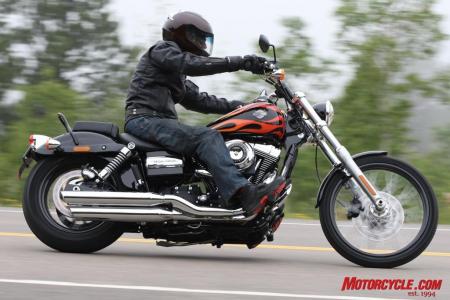 Black and chrome and flames are a powerful cruiser combination. |
Unlike the Softail line which is fitted with a counterbalanced 96-cubic-inch V-Twin, the Dyno line quells vibes via its rubber mounting. At cruising speeds, the motor is very smooth, but at idle and low revs, vibration is quite prevalent. As with all modern Harley powerplants, throttle response is excellent, reacting smoothly and precisely.
At Denver’s mile-high altitude, the impression of power from the TC96 is muted, and it is further diminished at the 9,000 feet we experienced in the Rockies. This is a very nice motor, but some of its competitors haves more grunt on tap. Peak torque arrives at 3,000 rpm, which supplies very usable power at mid-range revs. The Wide Glide's exhaust system limits cornering clearance on the right side.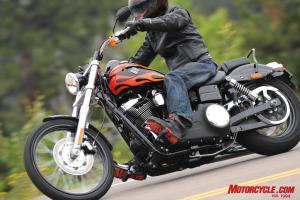
I wasn’t expecting stellar ride quality from the Wide Glide with its slammed suspension, but I was pleasantly surprised by its behavior. In most conditions it feels very composed, although it sometimes struggles to feel balanced when trying to absorb repetitive bigger hits, partly due to the wheels being set a lengthy 68.3 inches apart. And with the suspension loaded in corners, the rear shocks reveal a deficiency in rebound damping. I was impressed with the ground clearance available in left-hand corners, but the amount of lean angle is more limited in right-handers to protect the exhaust system.
Ergonomically, the WG is fairly benign. Its seat is firm but supportive, and the tank-mounted speedometer is easy enough to read. Self-canceling turnsignals are a convenient feature that should be standard on many other bikes.
Small niggles include the air cleaner that intrudes on space for a rider’s right knee and mirrors that fuzz at various rpm. A noticeable amount of heat can be felt radiating from the engine’s rear header, and the single-disc front brake can be diplomatically described as adequate.
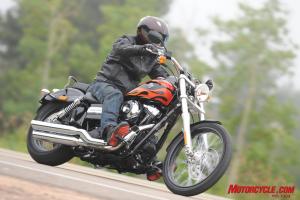
The Wide Glide’s attention-getting style can be had for less than $15,000.
Some may consider the above paragraph as damning with feint praise, but these are minor issues which don’t seem to bother the Harley faithful. For many, the gracefully sweeping lines of the attractive Wide Glide will be enough to sway them into joining the family of Harley faithful. There is no ignoring the many envious looks and comments the WG regularly drew throughout our time aboard it. This won’t get it down a canyon road as quick as some other cruisers, but it significantly adds to the pride in ownership.
Like all things in life, the more you spend, the cooler it gets. The $14,499 base price of the Wide Glide is for the handsome but subdued Vivid Black version. An extra $375 will upgrade you to the slightly more flamboyant but still stately Red Hot Sunglo. If you’re starving for attention, you’ll want the Vivid Black with clear-coated flames graphic for $15,194.
2010 Fat Boy Lo – Quick Ride
It didn’t take long after the Fat Boy’s 1990 introduction for it to achieve an iconic status – perhaps you recall a robot from the future that looked like an Austrian bodybuilder in a little film called Terminator 2. Its signature styling elements are a beefy FL-sourced fork, solid disc wheels and the 5.0-gallon Fat Bob fuel tank. Harley calls this newest iteration of the Fat Boy, the Lo, “a darker and lower interpretation of the motorcycle that still defines the fat-custom segment.”
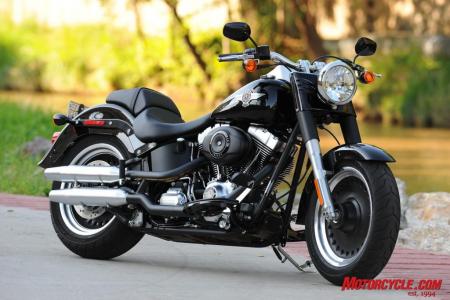 The Fat Boy Lo's contrasting finishes are a visual treat. |
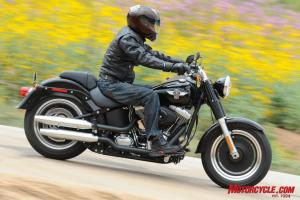 The Softail chassis underpins the chunky Fat Boy. |
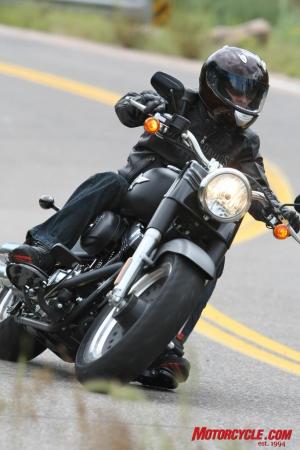 This shot demonstrates how the Fat Boy comes by its name honestly. |
The finishes from the Milwaukee company are above reproach, and this is evident on the Fat Boy Lo. Against a backdrop of gloss black and “Denim” black are lovely satin finishes on the engine and primary-drive covers and, most noticeably, on the mufflers of the shotgun exhaust pipes that glisten against the flat-black headers. It’s quite the eye-popper.
Also visually arresting are the 17-inch “Bullet Hole” cast-aluminum wheels with machined outer rims highlighting the black centers. Continuing the fat theme are a wide 140mm front tire and a 200mm rear. More fine detail work is found in the leather tank panel accented with an H-D medallion and a satin-chrome instrument console.
The transition to Lo status is the result of the Softail suspension being lowered 1.15 inches front and rear, plus a narrower seat, that results in the lowest seat height of any Harley: 24.25 inches. A reshaped handlebar completes the transformation.
The result is a very compact-feeling motorcycle for something that weighs 731 pounds wet. “Half Moon” floorboards are are placed well within reach and are very comfortable, but their shortcoming is that they drag early and often when riding on twisty roads.
The Softail platform uses the TC96B motor, which means that it has a counterbalancer to reduce vibration. This allows the engine to be mounted rigidly in the chassis, enhancing chassis stiffness compared to Harley’s rubber-mounted motors. The result is a better-handling motorcycle, but the reduced ground clearance means that you can’t fully exploit its potential.
My time aboard the Fat Boy Lo was too brief to provide a decent evaluation, but in terms of visual appeal, this is one of Harley’s finest work. The glossy Vivid Black version retails for $16,299, while the matte-finished Black Denim option has an MSRP of $16,674.
Sources: www.motorcycle.com

No comments:
Post a Comment